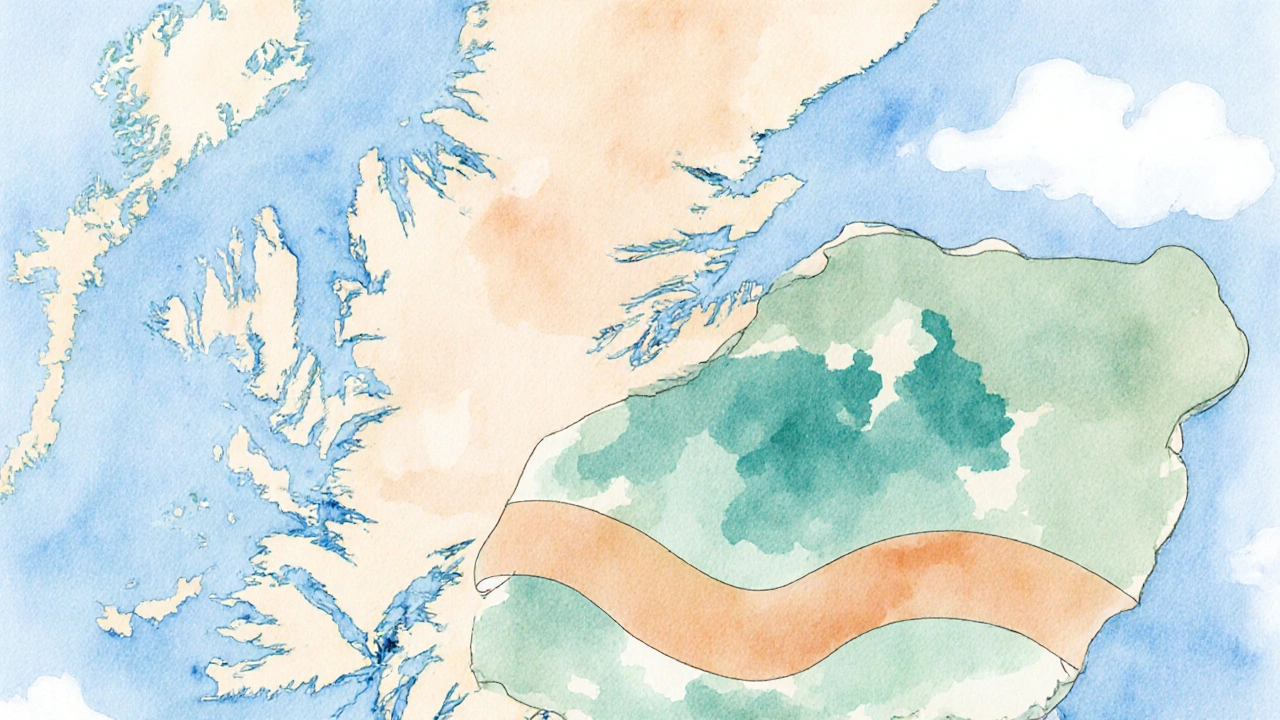
Scotland Midge Risk Calculator
When planning a trip to Scotlanda country of rugged coastlines, historic castles and misty highlands, most visitors dread the tiny blood‑sucking midgeCulicoides impunctatus, a bite‑prone insect that thrives in summer. The good news? Midges are highly seasonal, and with a little climate savvy you can schedule your holiday for a nearly midge‑free experience.
Why Midges Matter for Your Scotland Holiday
Midges aren’t just annoying; their swarms can turn a scenic hike into a buzzing nightmare. They love warm, damp air and are most active during daylight hours, especially in the early evening. Knowing the biology helps you understand when they’re likely to show up.
- Life cycle: Adult females emerge in late spring, lay eggs in moist soil, and repeat the cycle through the summer.
- Peak activity: Usually July and August, when temperatures sit between 15‑20°C and humidity is high.
- Geographic hotspots: River valleys, lochsides, and mountainous areas like the Highlandthe rugged northern region of Scotland and the Glencoea famous glen in the Highlands attract the biggest swarms.
Monthly Midge Risk Overview
Below is a quick reference that pairs average temperature, rainfall, and a simple risk rating (Low, Medium, High). All data are drawn from the Met Office’s 30‑year climate normals (1991‑2020).
| Month | Avg Temp (°C) | Avg Rainfall (mm) | Midge Risk |
|---|---|---|---|
| January | 2 | 100 | Low |
| February | 3 | 85 | Low |
| March | 6 | 80 | Low |
| April | 9 | 70 | Medium |
| May | 13 | 60 | Medium |
| June | 15 | 55 | High |
| July | 17 | 50 | High |
| August | 17 | 70 | High |
| September | 14 | 80 | Medium |
| October | 10 | 95 | Low |
| November | 6 | 110 | Low |
| December | 3 | 120 | Low |
Best Months to Travel If You Want to Dodge Midges
Based on the table, the sweet spots are:
- Late April to early May: Warm enough for outdoor activities, but midge populations are still building.
- Late September to early October: Temperatures dip, evenings cool, and the midge life cycle winds down.
Both windows give you best time to visit Scotland without the constant buzz. You’ll still enjoy long daylight hours, vibrant autumn foliage, and the country’s famous hospitality.

Regional Variations - Where Midges Are Less Likely
Even during peak months, some locations naturally see fewer insects. Here are a few examples:
- Isle of Skyean island off the west coast known for dramatic scenery: Coastal breezes keep conditions drier, reducing midge density.
- Shetlandthe northern archipelago with cooler, wind‑swept climate: Cooler summers mean lower activity.
- Islayan island famous for whisky and open landscapes: Its Atlantic exposure makes evenings less humid.
- Loch Lomondthe largest surface water in Great Britain: While popular, staying on the loch’s higher ground (e.g., the Trossachs) avoids low‑lying, peat‑rich zones where midges breed.
Choosing a destination with strong winds or coastal exposure can dramatically lower the bite factor.
Practical Tips to Keep Midges at Bay (Even if You Visit in Summer)
- Timing of day: Midges are most active from mid‑morning to early evening. Plan indoor activities or a midday rest during that window.
- Clothing: Wear long sleeves and trousers in light colors; bright colors attract midges.
- Repellents: DEET (20‑30%) or Picaridin are proven. Apply to exposed skin and clothing seams.
- Ventilation: Use fans in tents or open windows in accommodations; airflow disrupts midge flight.
- Avoid stagnant water: Midges lay eggs in wet soil and shallow pools. Choose camp sites away from boggy ground.
- Natural deterrents: Citronella candles and lavender sachets help in small outdoor spaces, though they’re less effective in dense swarms.

Sample Itineraries for a Midge‑Free Scottish Getaway
7‑Day Late‑April Adventure
- Day 1‑2: Edinburgh - Explore the Royal Mile, Arthur’s Seat, and enjoy city cafés before the warm weather arrives.
- Day 3‑4: Aberdeenshire Coast - Visit stone circles at Dunnottar, then head to the Isle of Skye via the coastal route. Late‑April breezes keep midges at bay.
- Day 5‑6: Glencoe & Fort William - Hike the Lost Valley early in the morning; mid‑day rest in the visitor centre where indoor displays keep you safe.
- Day 7: Return to Edinburgh - Catch a late‑afternoon train, enjoy a final dinner, and head home refreshed.
6‑Day Early‑October Escape
- Day 1: Glasgow - Discover the art scene, take a river cruise on the Clyde.
- Day 2‑3: Isle of Islay - Tour whisky distilleries; October’s cooler evenings limit midge activity.
- Day 4‑5: Shetland - Fly to Lerwick, explore the historic Hanseatic sites and dramatic cliffs.
- Day 6: Return via Edinburgh - Spend a relaxed final day in the capital before departure.
Both itineraries stick to the low‑risk windows and mix cultural, culinary, and natural highlights.
What If Midges Still Show Up?
Even in the best months, a sudden warm spell can bring a surprise swarm. Keep a small emergency kit with extra repellent, a fold‑up fan, and a waterproof jacket. Most locals will reassure you that the bite is more of an annoyance than a health threat.
Frequently Asked Questions
When is the absolute lowest midge risk period?
Mid‑November through early March offers the lowest risk because temperatures stay below the 10°C threshold most midges need to become active.
Do coastal areas really have fewer midges?
Yes. Constant sea breezes keep humidity lower and dry out the moist soil where female midges lay their eggs, so islands like Skye, Islay, and the Shetlands see far fewer swarms.
Is DEET safe for children?
A 10‑20% DEDE formulation is recommended for kids over two years old. Apply sparingly to exposed skin and avoid the face.
Can I use citronella candles inside my hotel room?
Most hotels allow small, battery‑powered citronella diffusers on balconies, but open‑flame candles are usually prohibited for safety reasons.
What alternative activities are good during peak midge months?
Focus on indoor attractions: museums in Edinburgh, whisky tastings in Speyside, or guided history tours in Stirling. Evening boat trips on Loch Ness also work well, as the water surface keeps midges away.
Comments (4)
-
James Boggs October 13, 2025
Thank you for the thorough breakdown; the tables make planning much easier. I appreciate the clear distinction between the low‑risk windows and the peak months. This will help me avoid the dreaded midges on my upcoming hike.
-
Thabo mangena October 30, 2025
Your guide shines a bright light on a often‑overlooked nuisance. It’s encouraging to see such a detailed seasonal analysis presented with optimism. I feel more confident choosing April or September for my Scottish adventure.
-
Karl Fisher November 16, 2025
Ah, the midsummer midge maelstrom – a veritable opera of buzzing torment that haunts the Highlands. Your eloquent exposition, dear author, elevates this humble arthropod to mythic status. One can almost hear the collective sighs of weary travelers as the tables turn, revealing the merciless calendar of doom. Yet, lo! You also unveil the graceful escape routes, those blessed coastal winds that whisper solace. The poetic cadence of your risk matrix dances like a Highland reel, each month a step in a grand choreography. I find myself yearning for the crisp, midge‑free breezes of early May, where the sun kisses the lochs without the sting of insects. The mention of Skye and Shetland as sanctuaries is a masterstroke, painting images of dramatic cliffs unmarred by buzzing beasts. Moreover, your practical tips read like a knight’s armament against the swarming horde – repellents, clothing, ventilation, all catalogued with scholarly precision. One could argue that you have turned a mundane travel advisory into a literary tour de force. May the reader heed your counsel and embark upon a pilgrimage free of those pernicious pests, lest they be forever haunted by the memory of a single, relentless bite. In sum, your guide is both a map and a manifesto, guiding us through the treacherous seas of seasonal insects with the poise of a seasoned bard.
-
Buddy Faith December 4, 2025
Sure the guide says summer is bad but the government hides the real data and the drones spread midges for control.
